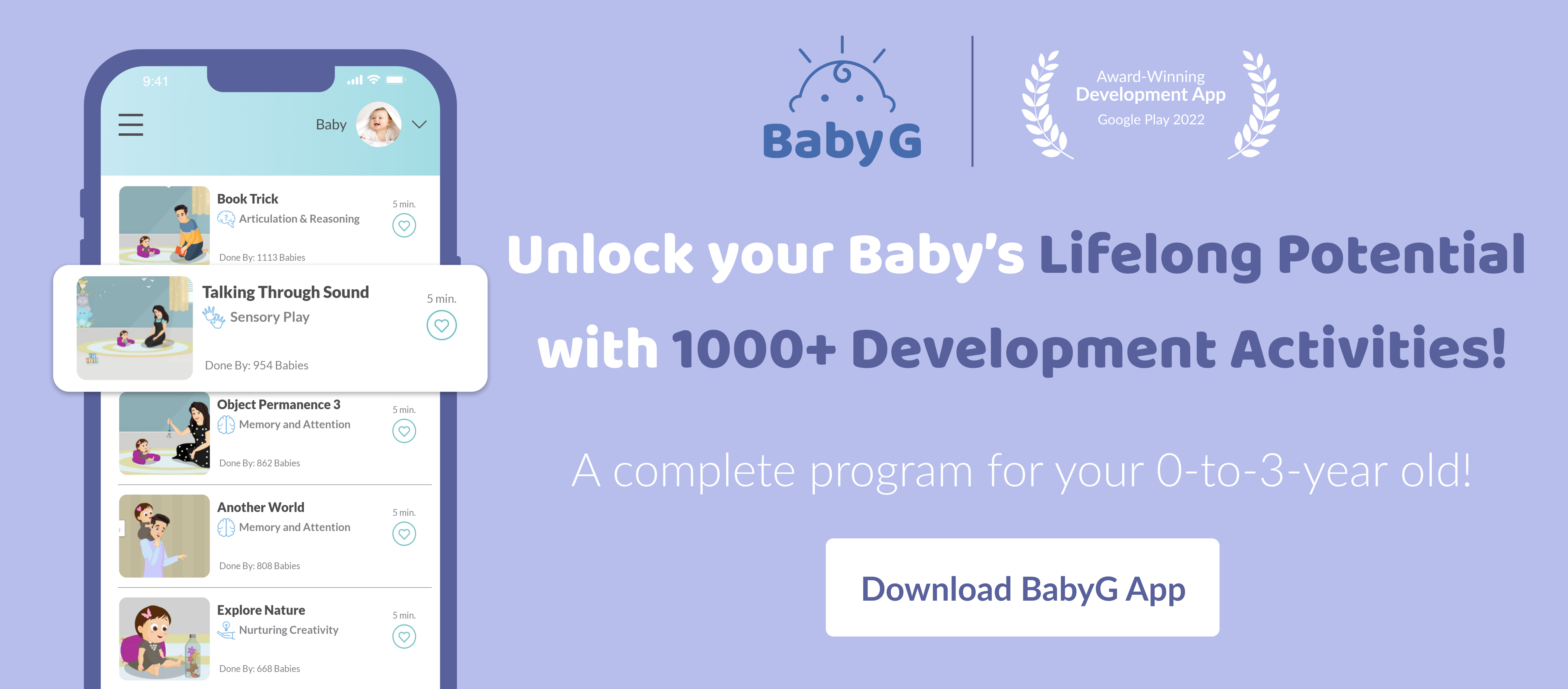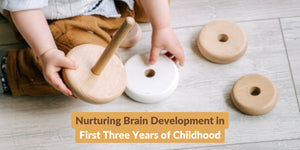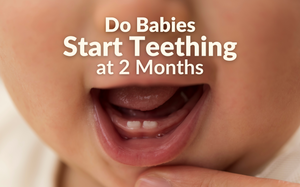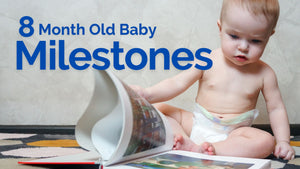
What Milestones Should A 4 Month Old Have?
Physical Development Milestones For 4 Months Baby
Your baby at 4 months will get a head start in their physical development with lots and lots of movement in the form of rolling over, grabbing, and reaching. Buckle up, because your baby is going to keep you on your toes. Here are the main physical milestones for 4 months
1. Able to Track Objects
This is one of the first signs that your baby has grown so much stronger than before. If your baby is able to follow objects like toys, rattles, or common things like a chair, etc., by moving their heads and eyes when your little one is placed on their tummy, then your baby has completed this milestone. They’ll not be able to move their heads very freely, but just enough to know where the object is going.Completion Rate on BabyG App: 82% Babies
Importance:This milestone signifies that your baby has better neck control and the shoulder muscles are developing on track. These are the stepping stones for gross motor development in your baby.
2. Able to Lift Neck in Pull to Sit Maneuver
If your baby is able to lift their head in the pull-to-sit maneuver as you pull them towards you, then they’ve completed this milestone. If your baby can't pull their necks up, try supporting them by laying them on your legs and raising them a little bit.Here’s a video to help you understand this milestone better.
Completion Rate on BabyG App: 79% Babies
Importance: Your baby’s neurological system is still developing, and being able to complete this milestone shows that your baby is on the right path. The neck flexor muscle responsible for head on neck contact will gradually strengthen from now on.
3. Able to Support Body with Hands
Lie your baby on their tummy and notice if your baby is able to support their body weight using their body with their arms. If your baby is able to achieve this, then physical development is headed in the right direction.Completion Rate on BabyG App: 66% Babies
Importance: Babies develop stronger arm and back muscles with this milestone, which allows them to have better motor development later in life.
4. Stronger Grip Using Hands
The primitive reflexes like palmar grasp that your baby is born with should be on the decline and completely disappear by 6 months. These should be replaced by voluntary movements such as grabbing onto a stuffed toy or rattle. The grip will become so strong that eventually they will be able to support their entire upper body. This comes under important gross motor milestones in four months.Completion Rate on BabyG App: 79% Babies
Importance: Only if your baby has reduced palmar grasp at this stage will they be able to open and close their hands more freely to do other things. Otherwise, they’ll always hold their hands in a clenched fist, which will delay fine motor development.
5. Can Balance the Body in Sitting Position
This is a newbie skill that your baby has just gotten into, so you might notice them being able to achieve this milestone but falling to the side due to a lack of balance. Your baby will need your support during this activity. Don’t worry, they’ve only started with it so only with time and practice can they master it completely.Completion Rate on BabyG App: 81% Babies
Importance: This is the foundation for all other movements your baby will be able to do over the next few months. If you see limp muscles or failing limbs, it could be a sign of hypotonia which is a serious concern that needs to be dealt with immediately.
6. Can Take Weight On The Legs
Try to hold your baby by their arms and let them stand on their own. See if they can support their body weight on their legs. This is only a beginner level skill for your 4 month old baby, so while they'll be able to do this, they’ll still wobble, but it’s a marker of early stage body balancing in your baby.Completion Rate on BabyG App: 77% Babies
Importance: It's an important milestone for them to achieve improved body balance, which will help them move ahead and walk and run later on.
7. Can Roll Over
At this milestone, your baby can move to the side position from the face-up position, and they can even go to the tummy down position from the side position. Your baby has just learned to do this, so they are definitely not going to be perfect at it, but you’ll see them trying for sure. This activity has to be encouraged as much as possible for physical development.Completion Rate on BabyG App: 60% Babies
Importance: This is a gross motor skill that is important to improve two kinds of senses- Vestibular which is when your baby understands balance, and Proprioceptive which is when your baby has body awareness to understand shifting their body weight.
8. Able To Take Toes in Mouth
Now that your baby has learned to gnaw on their tiny hands, the next step is to gnaw on their legs. This milestone is mostly driven by your baby’s curiosity about their body.Completion Rate on BabyG App: 44% Babies
Importance: This milestone is essential for your baby to figure out their legs and think of ways to use them. Trying to chew on them is the first step and is a part of self exploration.
What If My Baby Does Not Complete Physical Milestones?
Of these eight different physical milestones, a steady neck in a pull-to-sit maneuver, a strong grip on objects, the ability to move the head to either side, and the ability to support the body during tummy time are crucial for their development. If you see that your baby hasn't achieved these yet, first try to do some of the activities referred to in our activities section. If the problem persists, then talk to your pediatrician about your concerns. The rest of them are newbie skills, and it’ll take time to master them, so don't worry.4 Months Baby Activities To Reach Physical Development Milestones
1. Rolling
To complete the milestone “Can roll over” all you need to do is support them when they try to achieve this milestone. Lie your baby on a flat surface, then push gently towards one side and slowly give them a 360 degree rolling experience. At first, give them full support and gradually reduce the support; in no time, they will be able to do it all by themselves.Frequency: A couple of times a day for few weeks
2. Neck Movement
This activity will give them encouragement to complete milestones such as “Able to lift neck in pull-to-sit maneuver” or pretty much any movement that requires strong neck muscles. For this activity, rattle a toy on one side and wait for your baby to turn their head. Repeat this activity on both sides with different kinds of sounds and toys.Frequency: Once a day for few weeks
3. Eye Movement
The milestone “Able to track objects” can be completed using this activity. Place your baby on their tummy and move a toy from left to right at a distance that they wouldn't need to move their neck much and once they achieve eye tracking, increase the distance to encourage them to move their neck as well. This will help them develop vision as well as neck control.Frequency: Once a day for a week
Cognitive Development Milestones For 4 Months Baby
Since your 4 month baby’s eyesight is better than ever, they’ll start associating whatever they see with whatever they feel in terms of taste, sensation, and hearing. Here are some of the cognitive milestones in 4 months
1. Stares at far away objects in the room
You’ll notice that your baby gets excited and stares at toys that are kept far away. It could be in a corner of the room or kept on a shelf, but they will be constantly watching it. They like to observe things like the fan or anything in motion too. This is a sign that your baby has completed this milestone.Completion Rate on BabyG App: 94% babies
Importance: Your baby’s vision is blurry beyond 8 to 12 inches at birth, and this is the first time they can make out what’s going on beyond those 8 to 12 inches. They are curious, and staring at faraway objects will strengthen their vision and ability to focus on objects.
2. Improved short term memory
Your little one will start repeating certain actions like squeezing, rattling a toy, or hitting. All of these hint that they remember certain actions and are trying to do them again to get an understanding of how an action is done. You’ll also notice repeated reactions when they see people they might have seen earlier. For example, a grumpy grandpa gets your baby wailing every time they see him.Completion Rate on BabyG App: 80% Babies
Importance: Repeated motions indicate that your baby is on the right track to developing their brain, as memory is a very important function.
4. Opens Palm to Receive Toy
Now that their primitive reflexes are subduing slowly, you’ll notice them replacing these with voluntary movements like opening their palms in anticipation of grabbing a toy.
Completion Rate on BabyG App: 74% Babies
Importance: This means they are developing their brain and have started having interests like favorite toys, etc. This also shows a physical milestone because a reduced palmar grasp will help your baby hold onto objects willingly.
4. Day and night body schedule is established
You can finally sigh a heave of relief because your baby is sleeping through the night with fewer disruptions. This also means they are adjusting to circadian rhythms.Completion Rate on BabyG App: 83% Babies
Importance: The sooner they adjust to the daytime and nighttime sleep schedules, the better. Otherwise, they’d have sleep regression, which is an irregular pattern of sleep, and this will be difficult for both you and the baby.
What If My Baby Does Not Complete A Cognitive Milestones?
They have just started out in this category, so it's normal to not attain some of these milestones, like having a set day and night sleep schedule or even short term memory, if not all. Your baby can definitely achieve these milestones with the activities that we have listed to boost their cognition. But if you see that your baby is very lethargic and doesn't look around with curiosity, raise these concerns with your pediatrician.4 Months Baby Activities To Reach Cognitive Milestones
1. Explore Surroundings
Take your baby around the house, talk to them, and tell them about each thing in the house. Repeat this activity a few times a week, and you can help them achieve the milestone of “Improved short term memory”. Over time, they will start to recognize places and things in the home.Frequency: Every week 3 to 4 times a month
2. Neck Movement
We discussed this activity previously for improving neck muscles, but a part of this activity can help them achieve the milestone “Opens palm to receive toy”. In this activity, you show them a toy to encourage them to move their heads to either side, but notice if they try to open their arms to receive a toy. If they don’t show interest in receiving a certain toy, then try to switch it up for another rattle or soft toy. Once you know what gets them excited, repeat the activity, and eventually they’ll want to grab the toy voluntarily.Frequency: Once a day for a few weeks
Communication Development Milestones For 4 Months Baby
Your 4 month old baby will try to make all sorts of sounds, like the good old “aa eee oooh”. They may even say “dada” or “mama," but trust us when we say they don't mean it. They don't associate it with you and are only making random sounds with their mouth.
1. Looks in The Direction of The Person Speaking
Your baby is curious about the world, and one thing that gains their maximum attention is people speaking. You’ll notice that your baby looks in the direction of the person speaking. They also try to observe the person who is speaking and how they are speaking.Completion Rate on BabyG App: 91% Babies
Importance: Your baby is learning to communicate by observing and imitating the way we speak.
2. Shows Likes and Dislikes for Rhymes
You’ll notice that your baby doesn't groove to all kinds of rhymes. Just like we have preferences for certain music, they will start developing likes and dislikes for rhymes, toys, and literally everything. They will also try to communicate this with you by excitedly shaking their arms and legs and making noises by babbling or cooing.Completion Rate on BabyG App: 71% Babies
Importance: They are learning to communicate what they like and don't like by giving you cues. These cues will help you understand your baby better.
What if my baby does not complete a communication milestone?
If your baby is not paying attention to the person speaking, the first thing you have to do is get their hearing checked. Other milestones, like having preferences for rhymes, will only develop over time, so if you want to nudge your little one in the right direction, check out some fun activities that will help them achieve them sooner.4 Months Baby Activities To Reach Communication Developement Milestones
1. Making Sounds
Your baby will be able to achieve the “Looks in the direction of the person speaking” milestone. For this activity, all you need is a bell that you can tie to your baby’s hands or legs, and whenever they move, they hear the bell ring. Soon, your baby will be able to understand that they can make their own sounds and communicate with you. This will help them complete speech milestones for four months babyFrequency: 3 - 4 times during the week
Social and Emotional Development Milestones For 4 Months Baby
This is the start of the journey where you can have a lot of fun with your baby because they have started to learn social skills that will help them mingle with you and other familiar people. These are some of the milestones that mark four month old behavior changes.
1. Responds clearly to expressions shown by you
Your baby understands that smiling and laughing mean being happy, and crying is unpleasant, so they respond accordingly when you smile or make angry faces at them. If you try to play peek-a-boo, they’ll get excited. If you puff up your face and talk loudly, they’ll know that something’s wrong. With this, you can confirm the emotional development of a 4 month old baby.Completion Rate on BabyG App: 91% Babies
Importance: They will grasp that different emotions have different expressions. This also improves their visual learning skills and their ability to take cues from you to understand different kinds of emotions.
2. Shows excitement by moving arms and legs
If your little one is going gaga over their favorite toy or music, then your baby will try to show excitement by moving their arms and legs vigorously. Try taking away the same toy, and you’ll see that they start crying in no time. They basically try to express their emotions, whether it is happiness or frustration, using their bodies.Completion Rate on BabyG App: 94% Babies
Importance: Lack of such expressions may indicate a developmental delay.
What if my baby does not complete a social and emotional milestone?
These milestones, like responding to your expressions and showing excitement, are all achieved over time, and your baby wouldn’t connect socially and emotionally if they were overstimulated. If you suspect a developmental delay in your baby, as in that they don't smile at all, try encouraging them with some of the activities we have mentioned below.4 Months Baby Activities To Reach Social & Emotional Milestones
1. Expressions
Your baby will learn social and emotional skills primarily from you. They will observe and try to imitate you. So all you need to do is talk with your baby with a lot of expressions. Make grumpy faces, funny faces, and frowns, and try to get as many variations as you can because then your baby will learn to make them by themselves. The easiest and most engaging way to do this is by using the best stories for four months babies.Frequency: Multiple times every day for the next 2-3 weeks
What Should Be My Baby’s Weight, Height and Head Circumference at 4 Months?
Every baby has a different growth curve, so you only have to worry if you see that they differ by a huge amount from the vitals stated below.
Average Weight for 4 Month Boy: 7 kg / 15.4 pounds / 246 ounce
Average Weight for 4 Month Girl: 6.4 kg / 14.1 pounds / 225 ounce
Average Height for 4 Month Boy: 63.9 cm
Average Height for 4 Month Girl: 62.1cm
Average Head Circumference for 4 Month Boy: 37.1cm
Average Head Circumference for 4 Month Girl: 36.4cm
4 Month Old Feeding Milestones
All 4 month olds aren't the same, so you would definitely need to tweak these according to your baby’s needs. A healthy weight gain over time and the number of diaper changes, which should be around 10, should tell you a fair share of their development. Here’s a definitive schedule to know whether your baby is on track
Breastfed Babies: 6 -10 feedings per day, each feed of 10-20 minutes
Formula-fed Babies: 5 - 6 ounces (120-150 mL), 5-6 feedings per day
4 Month Old Sleeping Milestones
Now that your baby is four months old, they'll likely sleep through the night for a span of 4 or 5 hours at the very least. Apart from this, they’ll sleep for 9 to 10 hours during the day, which means they’ll be asleep for almost 15 hours a day. You can check if your baby is hitting the required time for sleeping using a newborn baby sleep tracker.
When To Worry About 4 Month Baby’s Development Progress?
Your baby may not complete some of these milestones, which could point towards developmental delays. If you see any of these signs, consult your pediatrician immediately
- Does not respond to loud noises
- Does not babble
- Begins babbling but does not try to imitate sounds
- Has difficulty moving one or both of his eyes in any direction.
- Won’t smile at people.
- Doesn’t bring his hands to his mouth.
- Won’t push down with his legs when he’s put on a hard surface.
- Can't hold his head up steadily.
How To Support My 4 Month Baby's Development?
4 months is the time when you can have maximum fun with your little one. They are very excited about their environment, and they’ll make sure you know they are excited.
One thing that you should maintain from here on is conversations with your baby. Keep talking, and eventually they’ll start making sense of it. Talk with expressions and different voices, which is very important for your baby’s development. Also, try setting a routine, which will help them start aligning with your routine.
Apart from this, they are also strengthening their muscles and cognition, all of which needs to be noted and tracked. We’ve made the 4 month old baby milestones checklist so you don't have to worry about any developmental delay and can easily spot red flags, if any. And even if there is a problem, there isn't anything that a little activity can't solve, which is also given milestone wise on the BabyG app.
Apart from this, understanding poop, pee, and sleep patterns can tell a lot about your baby, and logging them would surely be helpful. We equip every parent with resources in the most simplified way possible to save both your time and energy, which could be better spent on your baby.
Oh boy, 5 months is a crazy ride altogether! To know what lies ahead for your baby check out milestones for 5 months baby and gear up for the next big step.













LEAVE A COMMENT